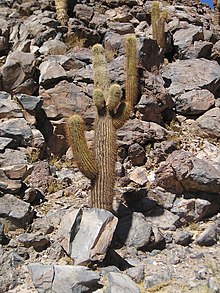Echinopsis atacamensis
| Echinopsis atacamensis | |
|---|---|
 |
|
| Scientific classification | |
| Kingdom: | Plantae |
| Clade: | Angiosperms |
| Clade: | Eudicots |
| Order: | Caryophyllales |
| Family: | Cactaceae |
| Subfamily: | Cactoideae |
| Genus: | Echinopsis |
| Species: | E. atacamensis |
| Binomial name | |
|
Echinopsis atacamensis (Phil.) H.Friedrich & G.D.Rowley |
|
Echinopsis atacamensis (cardón) is a species of cactus from Chile, Argentina and Bolivia. The wood of this species can be used in building and in making furniture.
Echinopsis atacamensis has a tall columnar habit, sometimes forming branches and becoming treelike. It grows to about 10 m (33 ft) high, with stems to 70 cm (27.6 in) across. The stems have 20-30 ribs and areoles with 50-100 maroon coloured spines, the longest up to 30 cm (12 in) long. The rose-white flowers are 10–14 cm (3.9–5.5 in) long, borne on the sides of the stems. The dark green fruits are densely covered with hairs, up to 5 cm (2.0 in) long; they are edible.
Echinopsis atacamensis was first described by Rodolfo Philippi as Cereus atacamensis in 1860. It was placed in a number of genera, including Trichocereus and Helianthocereus, before being moved to Echinopsis by Helmo Friedrich and Gordon Rowley in 1974.
There are two recognized subspecies. Subspecies pasacana is often branched, and occurs in Argentina and Bolivia. Subspecies atacamensis is usually unbranched, less tall (up to 6 m (20 ft) rather than 10 m (33 ft)), and is found in Chile.
...
Wikipedia
